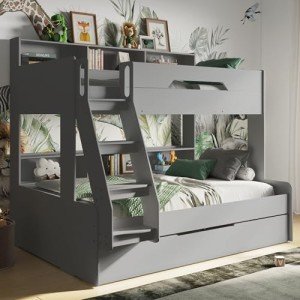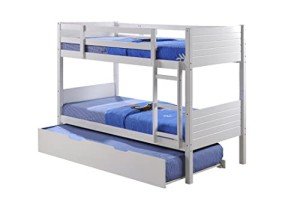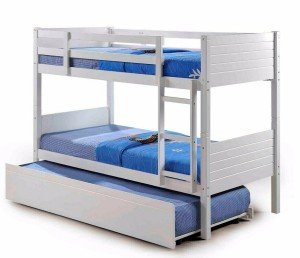In modern households, particularly those that are space-challenged, finding practical furniture solutions that cater to the needs of growing children can often resemble a complex puzzle. Among the myriad of options available, kids’ bunk beds with trundles stand out as an increasingly popular choice. Combining functionality and style, these versatile beds not only save space but also provide additional sleeping arrangements suitable for sleepovers, siblings sharing a room, or unexpected guests. In this article, we explore the numerous advantages of bunk beds with trundles, important considerations when choosing one, and a few practical tips to maintain safety and durability.
Understanding Bunk Beds with Trundles
A bunk bed is a type of bed in which one bed frame is stacked on top of another, maximizing vertical space. A trundle bed is an additional bed that can be stored beneath the main bed frame and pulled out when needed. A bunk bed with a trundle combines these two concepts, offering a top bunk and a trundle bed below for flexible sleeping options.
Key Benefits
-
Space-Saving Solution:
- Ideal for smaller rooms, bunk beds with trundles efficiently utilize vertical space.
- Allow for more usable floor space in kids' rooms, making way for play areas or additional storage.
-
Extra Sleeping Space:
- A perfect solution for accommodating guests or having siblings share a room.
- The trundle can be used for sleepovers, making it a versatile choice for social kids.
-
Cost-Effective:
- Purchasing a single bunk bed with a trundle can be more economical than buying separate beds.
- Long-term use as children grow into teens makes this an investment that maximizes value.
-
Stylish Options:
- Available in various designs, colors, and materials to match any bedroom theme.
- Well-designed beds can be a focal point in the room, appealing to both children and parents.
-
Encourages Bonding:
- Sharing a room and beds can foster a close bond among siblings.
- Creates an inviting space for friends and sleepovers, enhancing social interactions.
Choosing the Right Bunk Bed with Trundle
When selecting a bunk bed with a trundle, several factors must be considered to ensure it meets the family's needs while prioritizing safety and design. Here’s a checklist of important considerations:
-
Safety Features:
- Look for sturdy construction materials (solid wood or metal).
- Ensure the top bunk has guardrails on both sides to prevent falls.
- Check that the ladder is secure and spaced correctly for easy access.
-
Size and Dimensions:
- Measure the room to ensure there is enough height for the top bunk and adequate space for the trundle to extend.
- Consider mattress size - twin and full sizes are the most common.
-
Weight Capacity:
- Check the weight limit for both the top bunk and trundle to ensure it can accommodate the intended users.
-
Ease of Use:
- The trundle should be easy to pull out and push back in.
- Ensure that children can safely access and use the top bunk.
-
Style and Theme:
- Choose a design that fits well with the existing decor of the room.
- Options may include traditional wood finishes, contemporary metal styles, or themed designs (like castles or space).
Maintenance and Safety Tips
The longevity and safety of a bunk bed with a trundle rely heavily on proper care and maintenance:
-
Regular Inspection:
- Check the structure periodically for any signs of wear, including loose screws or broken slats.
- Tighten any loose bolts or hardware to prevent accidents.
-
Mattress Care:
- Use quality mattresses that fit snugly to avoid gaps where items might fall.
- Rotate mattresses regularly to prolong their lifespan and maintain comfort.
-
Encourage Safe Use:
- Teach children proper usage of the ladders and bunk; no roughhousing allowed!
- Ensure that the trundle bed is only used for sleeping, as it can be tempting to use it for play.
-
Keep the Area Clear:
- Maintain a clean and clear area around the bunk bed to reduce the risk of tripping or falling.
Frequently Asked Questions (FAQs)
Q1: What age is appropriate for children to sleep in a bunk bed?
A1: Most manufacturers recommend that children aged six and older should sleep in the top bunk due to safety concerns. Younger children can use the trundle bed but should be supervised.
Q2: Can a trundle bed accommodate a regular-sized mattress?
A2: Trundle beds typically accommodate twin-sized mattresses. However, some models are designed to support full-sized mattresses, so it's essential to check specifications.
Q3: How do I prevent my child from falling out of the top bunk?
A3: Ensure that the bunk bed has sturdy guardrails on both sides. It’s also advisable to place the bed against a wall if possible.
Q4: Can I use a bunk bed as a primary bed for my child?
A4: Yes, many families use bunk beds as the main sleeping arrangements. They are designed to be durable and long-lasting, suitable for everyday use.
Q5: Are bunk beds with trundles hard to assemble?
A5: Assembly difficulty varies by model, but most come with detailed instructions. Having a second person to assist during assembly can make the process easier.
Kids’ bunk beds with trundles are more than a stylish solution for cramped rooms; they reflect the creativity and flexibility that modern family life demands. As they adapt to diverse space requirements while fostering friendships, these beds represent both practicality and functionality. With careful selection and consistent maintenance, a bunk bed with a trundle can serve as a long-lasting sleep solution that not only maximizes space but also enriches childhood experiences.






